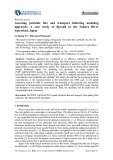
Rice pesticide
-
Modeling approach has considered as an effective alternative method for environmental risk assessment in recent decades. This work aimed to assess the pesticide fate and transport from rice paddy which has higher potential of pesticide runoff compared to upland fields as reported in previous studies. The study area was the Sakura River watershed, Ibaraki Prefecture, Japan.
 9p
9p  viyoko
viyoko
 01-10-2024
01-10-2024
 4
4
 1
1
 Download
Download
-
Research and production of clean, high-quality and high-yield rice, sustainable environmental protection are the most important and important tasks of many countries in the world as well as in Vietnam today. Therefore, the research, selection and creation of rice varieties that are both high-yield and resistant to pests, weeds, and climate change, in order to minimize the use of herbicides and pesticides.
 8p
8p  viindranooyi
viindranooyi
 07-05-2022
07-05-2022
 14
14
 1
1
 Download
Download
-
The objects of this study is the use of pesticides of the farmers in the Mekong River delta. The respondents are the farmer households who have planted rices for three years up to the interview date.
 44p
44p  kethamoi12
kethamoi12
 15-05-2021
15-05-2021
 17
17
 3
3
 Download
Download
CHỦ ĐỀ BẠN MUỐN TÌM
















